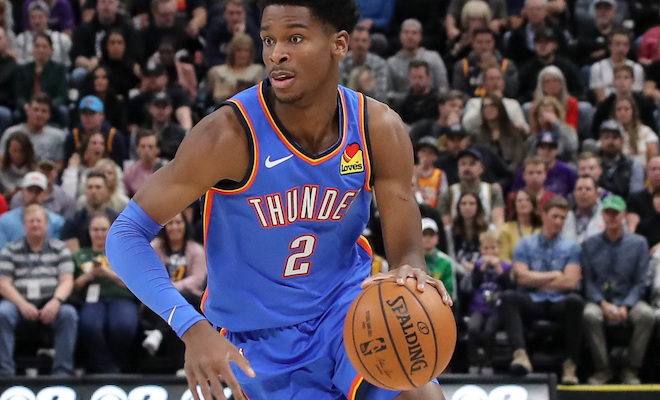-
 December 5, 2019, 1:54 am
December 5, 2019, 1:54 amGiven their roster construction, it should not come as a shock that the Thunder are a guard-heavy team. Exactly what they’re doing with their deployment, however, has the team set up to make some minor history.
We’re not talking about a significant record or something that will burn its way into the collective memory of NBA fans, or maybe even Thunder fans, but it’s an interesting way for Billy Donovan to maximize the use of some of his best players.
The trio of Shai Gilgeous-Alexander, Chris Paul and Dennis Schroder has seen heavy run. The Thunder fell into this roster when Paul George asked to be dealt away, and the three PGs are all among the top four on the team in terms of both minutes per game and usage. Gilgeous-Alexander is OKC’s new centerpiece, while Paul is still clearly too good to bench even if he doesn’t fit the team’s timeline and Schroder offers much-needed scoring ability on a team that has a limited group of shot-creators.
Injuries and uninspiring play from the Thunder’s collection of shooting guards and small forwards has made it easier to find time for all three, though the extent to which they’re playing and consuming touches is something that we haven’t seen frequently before.
Heading into Wednesday’s game, the three were averaging:
Chris Paul: 30.5 minutes, 15.7 points, 4.2 rebounds, 5.7 assists, 1.7 steals, 1.7 threes on .456/.386/.886 (FG/3P/FT) and 21.5% usage
Shai Gilgeous-Alexander: 34.5 minutes, 18.2 points, 5.1 rebounds, 3.1 assists, 0.9 steals, 0.5 blocks, 1.5 threes on .437/.359/.779 and 25.1% usage
Dennis Schroder: 28.8 minutes, 15.5 points, 3.9 rebounds, 3.9 assists, 0.8 steals, 0.3 blocks, 1.4 threes on .445/.297/.765 and 27.0% usage
Nothing too groundbreaking in there in any single stat, but the burden that the team is placing on its guards is atypical.
Looking back through league records (thank you to the fine folks of Basketball Reference), since the 1977-78 season, only 18 teams have had three guards average at least 28 minutes with a usage rate of 20.0 over the course of a season.
Some of this is also a reflection of the modern game. While there are only a handful of teams to meet these admittedly arbitrary benchmarks in the past, the second time it’s ever happened for multiple teams in the same season happened in 2017-18, with the Rockets (Paul, James Harden and Eric Gordon) and Nuggets (Jamal Murray, Gary Harris and Will Barton) pulling it off. Murray was at 22.8 while Harris and Barton had matching usage rates of 20.7, putting them third and tied for sixth on the team, so it’s a little bit of a different set of circumstances even though the usage met our requirements.
That trio of Rockets also made the list for last season’s efforts, making them the only group to make the list twice.
Of those 18 teams, 11 of them have been from the last 20 seasons. Seven of them have been from the last 10.
Some of the groups that made the list were generously included, as they featured midseason acquisitions who may well have cramped everyone’s style had they spent the full season with their criteria-meeting teammates; the 2008-09 Bulls (Derrick Rose, Ben Gordon and acquisition John Salmons) and 2002-03 Bucks (Sam Cassell, Michael Redd and Ray Allen and Gary Payton, who were traded for one another) are in that group, as are the 1996-97 Nets who actually had five players meet the standards of our unscientific test. Kendall Gill, Kerry Kittles, Robert Pack, Sam Cassell and Jim Jackson all managed the feat while playing in New Jersey uniforms, though Jackson and Pack were traded to Dallas in the deal that brought back Cassell.
When we filter out the trios that didn’t average at least 15 points apiece, that list shrinks from 18 to eight.
Those aforementioned Rockets, Nuggets, Bulls, Bucks and Nets teams all qualified, as did the 2013-14 Clippers (Paul, J.J. Redick, Jamal Crawford) and the 2006-07 Warriors (Baron Davis, Monta Ellis, Jason Richardson). Even with this quick and dirty look at high-usage guard rotations, it’s clear that their rise has been in relative lockstep with the changes that have resulted in the modern NBA. Still, most of those teams have one true point guard and a couple of pure scorers. The Thunder are definitely not built like that.
To wit, this season we have three more teams beyond OKC – the Heat, Warriors and Nets – that could join the club, though missed games and positional alignments could mess that up.
As it stands, however, the Thunder are doing something that’s fairly unique in how they’re using their personnel. It’s not hard to understand why, given the team’s makeup, but it is still fairly unorthodox in the grand scheme of things.
It also begs the question of how this will play out as the year goes on. Gilgeous-Alexander is the only player guaranteed to be on this roster past the deadline, and as such his production should be expected to continue.
Paul and Schroder, however, could be very attractive trade targets for real contenders in a year where up to a dozen teams might think they have a shot at legitimate contention.
Who’s to say that the Thunder, who are obviously rebuilding but have the look of a semi-competitive team, decide to move out key players if the returns aren’t there? Oklahoma City sits just two games out of the final playoff spot, and a few of the teams immediately above them have plenty of questions to answer. To say nothing of leading scorer Danilo Gallinari, who should fetch a haul on the open market. CP3 and Schroder both have term left on their deals, giving OKC the option to test the trade waters again next year when they have a better idea of Gilgeous-Alexander’s strengths, weaknesses and upside.
Beyond whatever offers come their way, the Thunder’s decision should rest with the preferred developmental path of SGA. The team will have to wrestle with whether it’s more valuable for Gilgeous-Alexander to be learning the ropes from one of the era’s best point guards in Paul or for him to be getting as many minutes as he can handle as the team’s true point guard himself. This year he’s spent 84% of his minutes at shooting guard, 14% at small forward and only 2% at point guard, per Basketball Reference’s position estimates. That versatility is good, but SGA’s long-term fit should be running point.
And if Paul does last past the deadline, his minutes will surely be cut if the team fades from the playoff picture. The Thunder may be able to get the best of both worlds to some extent, though they risk running afoul of Paul if they hold him and then bench him. Again, he’s too good for the shutdown treatment as long as he’s healthy, and frankly deserves better than that as well.
Until those decisions are made, however, you can expect to keep seeing the Thunder lean on their backcourt more than any team in the league.
Oklahoma City is in a very unique spot in terms of their placement in the league hierarchy and how their current roster fits their long-term goals. What’s showing up as a statistical quirk right now could end up playing a major role in the Thunder’s future one way or another.
Subscribe
Login
0 Comments
